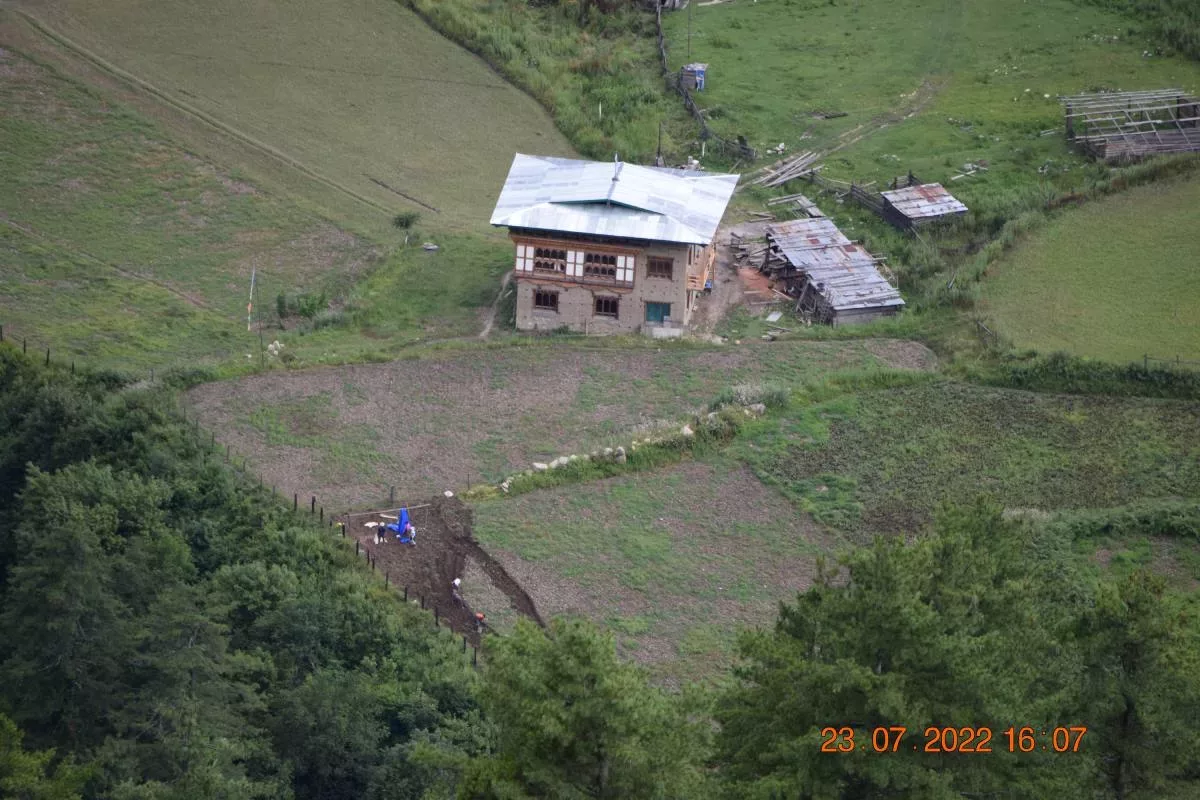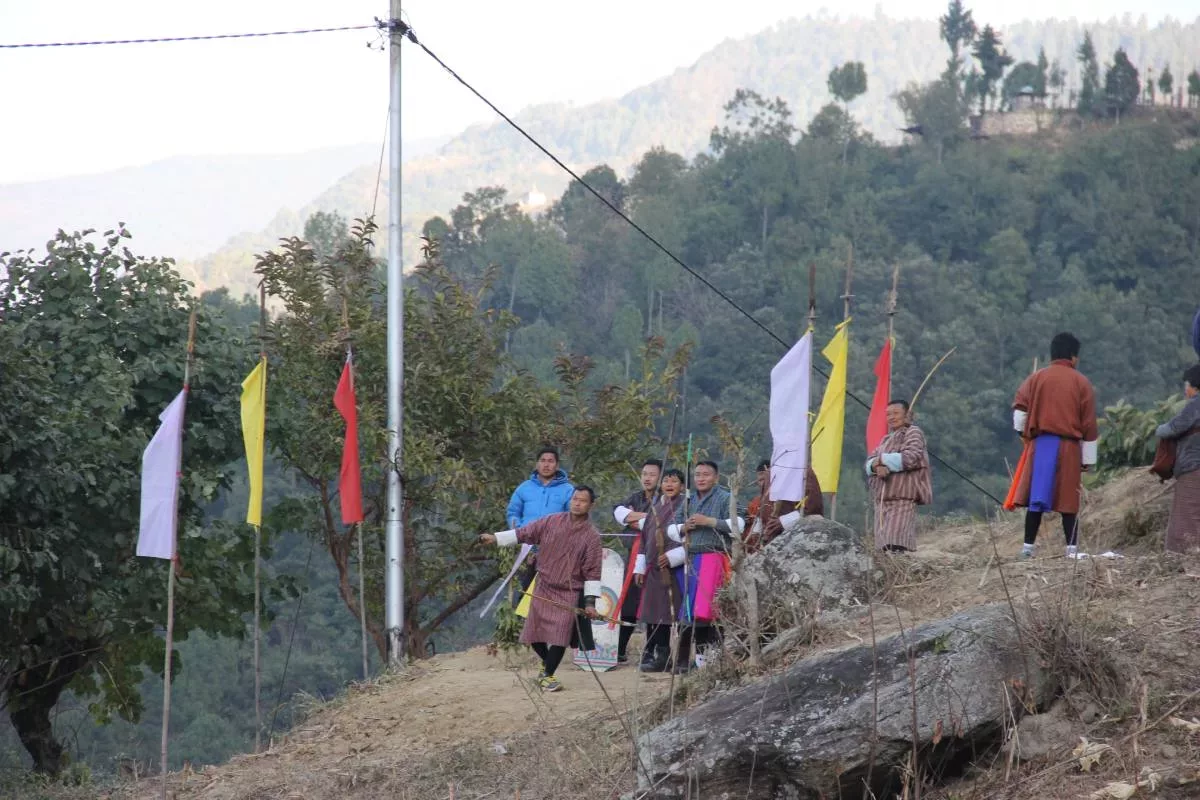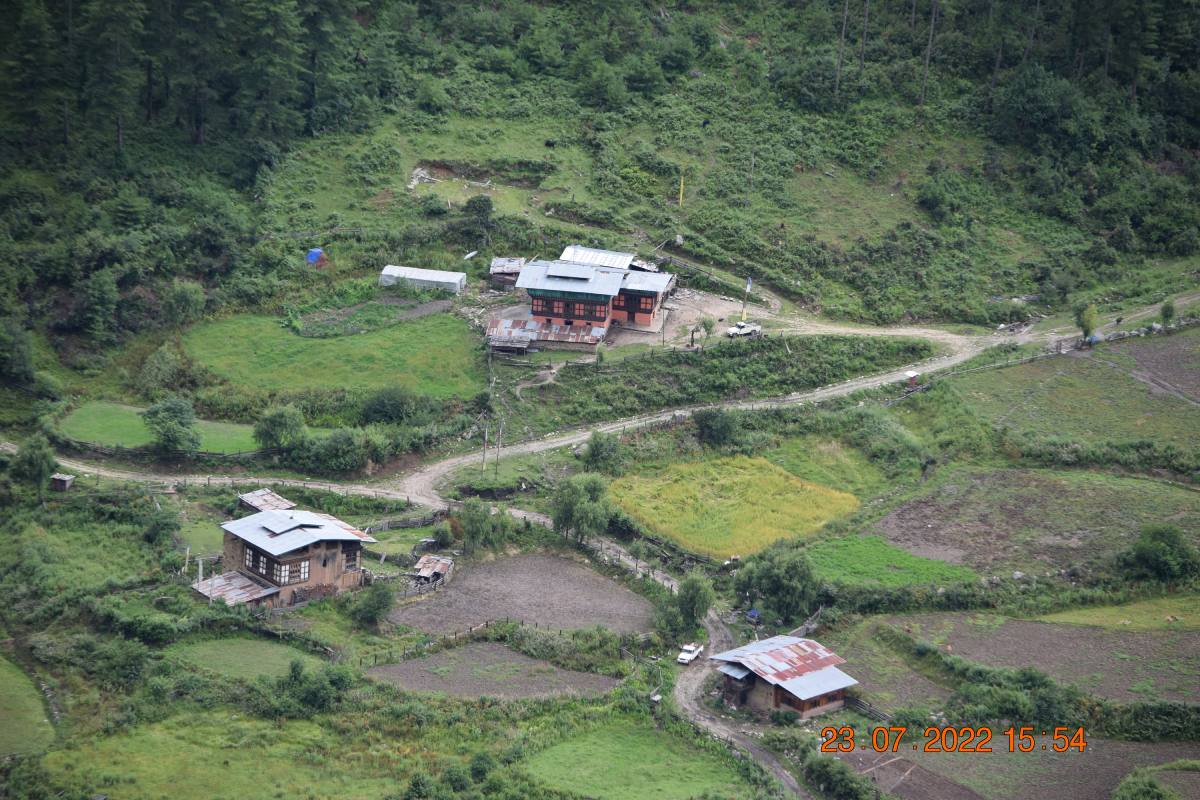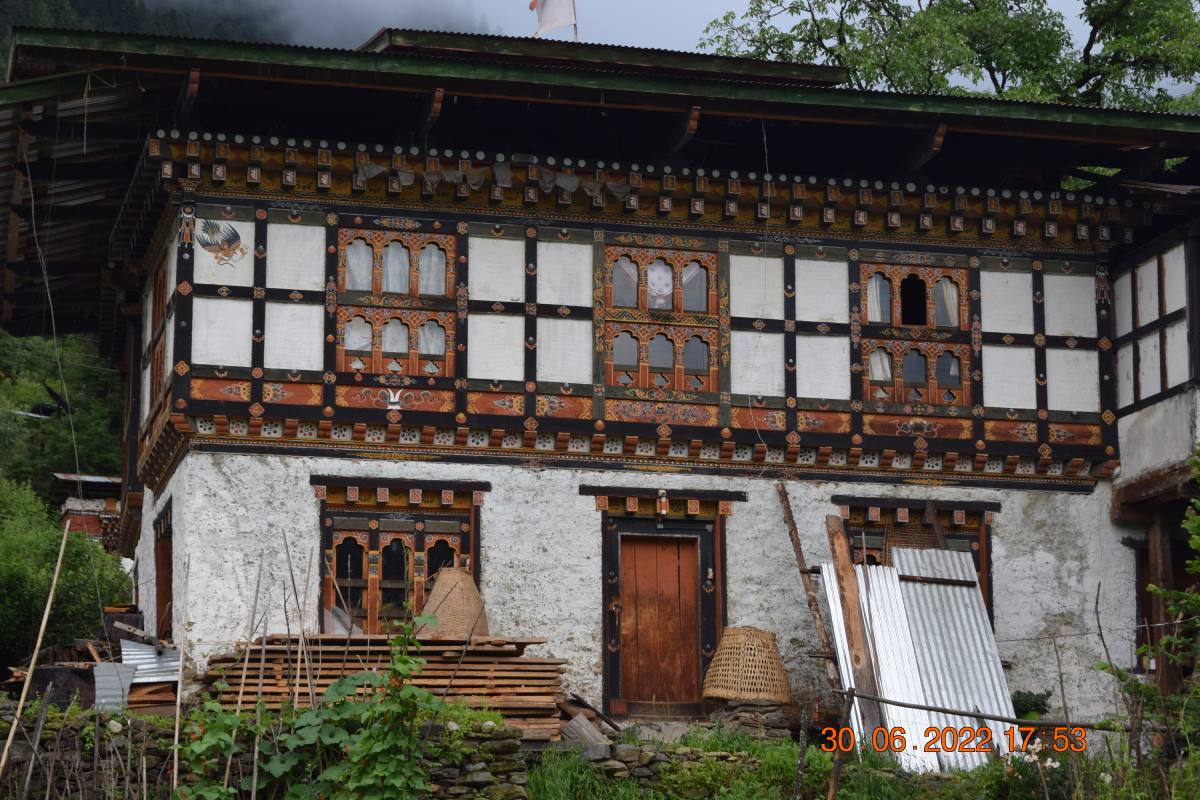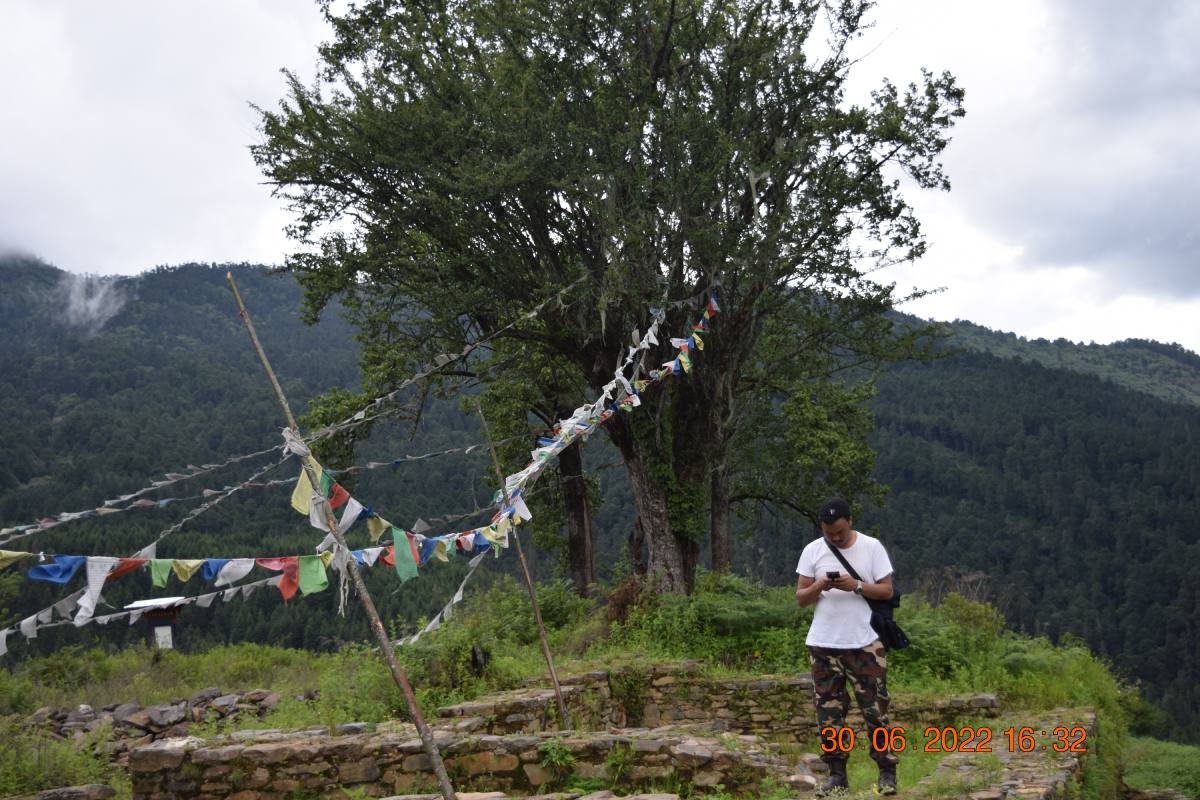Detailed Program
Today you will arrive in Paro, either by flight from Delhi, Kolkata, or Kathmandu or by land from Phuntsholing, the border town with Sikkim. In Paro, you spend the first time in people’s homes, on the farm of Ap Tshering. A special experience because you experience rural life up close. In the evening there is traditional cooking for you and there is the possibility to take a bath, also in a completely traditional way. Bhutan has traditionally been an isolated and closed country.
The mountain ranges form a natural separation from neighboring countries, and the country was also inaccessible to tourists for a long time. The penultimate 4th king, Jigme Singye Wangchuk, slowly opened up the country to the outside world during his period of power and admitted the first tourists. This king has become best known in the west for his remarkable philosophy on the development of the country, with a focus on Gross National Happiness rather than Gross National Product. In March 2008, he voluntarily transferred power to his son Jigme Khesar Namgyal Wangchuk, an event that coincided with the country’s first democratic elections.
The king is still formally head of state, but can now be deposed by parliament. The young king, like his father, is very popular with the locals. His portrait is prominently displayed on the wall in almost all houses and shops and many Bhutanese proudly wear a button with his image. where it is preferable to look at Gross National Happiness rather than Gross National Product. In March 2008, he voluntarily transferred power to his son Jigme Khesar Namgyal Wangchuk, an event that coincided with the country’s first democratic elections. The king is still formally head of state, but can now be deposed by parliament.
The young king, like his father, is very popular with the locals. His portrait is prominently displayed on the wall in almost all houses and shops and many Bhutanese proudly wear a button with his image. where it is preferable to look at Gross National Happiness rather than Gross National Product. In March 2008, he voluntarily transferred power to his son Jigme Khesar Namgyal Wangchuk, an event that coincided with the country’s first democratic elections. The king is still formally head of state, but can now be deposed by parliament. The young king, like his father, is very popular with the locals.
His portrait is prominently displayed on the wall in almost all houses and shops and many Bhutanese proudly wear a button with his image. The king is still formally head of state, but can now be deposed by parliament. The young king, like his father, is very popular with the locals. His portrait is prominently displayed on the wall in almost all houses and shops and many Bhutanese proudly wear a button with his image.
The king is still formally head of state, but can now be deposed by parliament. The young king, like his father, is very popular with the locals. His portrait is prominently displayed on the wall in almost all houses and shops and many Bhutanese proudly wear a button with his image.
Places and attractions:
- Rinpung Dzong
- Drukgyel Dzong
- Taktshang
- Kyichu Lhakhang
- Kila Gompa
- Dungtse Lhakhang
- Tachog Lhakhang
- Dzongdrakha
Accommodation options:
Paro is a small provincial town, located in the beautiful Paro valley. Walking through the streets you immediately notice a few typical Bhutanese expressions; the characteristic construction of the houses, the traditional clothing of the population (the Gho for men and the Kira for women), and the many red peppers that dry in bunches hanging from the window frames.
The pepper is a widely used ingredient in the very spicy Bhutanese cuisine; the national dish is ‘chili with cheese. On the edge of Paro is the imposing Paro dzong, a square structure that you enter via a drawbridge. A dzong is a typical Bhutanese structure that you can admire in many places during your journey through Bhutan. It is a fortified settlement and is home to both provincial and secular power. A kind of abbey and provincial house in one.
When entering the dzong, the Bhutanese men must wear their traditional scarf showing their rank (for example, citizen or civil servant), and they may only enter the dzong in their obligatory Bhutanese clothing and leather shoes. Although you can visit most dzongs as a tourist nowadays, you can never go to all areas, there are always spaces in which to work or sacred spaces that are closed. Fortunately, there is still plenty to admire from the courtyards. Tourists do not have to adhere to dress codes, but of course you have to dress decently.
It will not surprise you that the beautiful dzong of Paro was the setting for the famous film ‘Little Buddha’ by Bernardo Bertolucci. Just above the dzong is the National Museum, located in the old watchtower (ta dzong). It is an interesting museum and many art treasures can be admired in the many round corridors. The whole gives a nice overview of the history and daily life in Bhutan. Not far outside Paro is Taktshang Goemba, the Tiger Nest Monastery. Due to its spectacular location, perched on a steep rock face, this is by far Bhutan’s most famous monastery. It is a beautiful, but tough walk to the monastery. The path goes uphill almost non-stop.
After about an hour you will reach the first viewpoint at the teahouse. Here you can enjoy a drink while enjoying the view of the monastery across the street. You can also go up by horse to the teahouse, but discuss this with your guide in advance so that he can arrange this in time. Enthusiasts can walk even further from the teahouse to visit the monastery itself. The path then continues on to steps carved into the rock, surrounded by fluttering prayer flags.
When entering the monastery you have to hand over your bag and camera, because you are not allowed to take pictures inside. You should also be dressed respectfully, so no bare arms and legs, and preferably nothing tight-fitting. Make sure you have some change ready so that you can make a small donation to the temples, just like the locals. You can visit several rooms in the monastery, including the cave in which Guru Rinpoche would have meditated for three months. During a fire in 1998, large parts of the monastery were destroyed, but this cave miraculously remained virtually undamaged.
Places and attractions:
- Rinpung Dzong
- Drukgyel Dzong
- Taktshang
- Kyichu Lhakhang
- Kila Gompa
- Dungtse Lhakhang
- Tachog Lhakhang
- Dzongdrakha
Accommodation options:
From Paro, you travel in a few hours to Haa, a beautiful valley on the border with Tibet. This valley has only recently been opened to tourists and is rarely visited. It is a beautiful route through the highest pass in Bhutan, the Cheli La (3988 meters), which is always dotted with prayer flags. From here you have a beautiful view of the snowy mountain ranges with the impressive peak of the Jhomolhari (7314 meters) as the highest point.
In the valley, you visit the village and the local dzong. You will be a guest tonight at the farm of Puntsho Norbu in the village of Katso. It is a very simple accommodation, but the cordiality of the owners more than makes up for the lack of comfort. You can also choose to stay in a guesthouse in Haa.
Places and attractions:
Accommodation options:
You continue the tour to the capital of Bhutan, Thimphu. Although Thimphu is a real city nowadays – it is the only place in Bhutan with traffic lights – the atmosphere is still small and village-like. In Thimphu, visit the large archery stadium where matches usually take place, it is the national sport in Bhutan and a match always attracts a lot of attention.
You can also view one of the many monasteries or the national Peace Chorten. But it is also nice to just stroll through the city; in the main street, there are many shops and squares where you can observe daily life from a bench. Of course, you will also visit the imposing dzong of Thimphu today or tomorrow. This dzong houses the working rooms of the king, whose palace is diagonally opposite. The security checks for a visit to the dzong of Thimphu are therefore much stricter than elsewhere in the country.
At the end of the day, you can visit the small zoo, located on the outskirts of the city. The zoo is entirely dedicated to the national animal of Bhutan, the takin; a unique animal that most resembles a deer-like variant of the wildebeest. In Thimphu, you spend the night in a hotel in the center of the city.
Places and attractions:
- Tashichho Dzong
- Semthoka Dzong
- Dochu La Pass
- Memorial Chorten
- Changangkha Lhakhang
- Zangdopelri
- The Tallest Buddha Image
- Tango And Cheri Monasteries
- The Handicrafts Emporium
- Traditional Medicine
- Zorig Chusum Institute
- National Library
- Weekend Market
- Botanical Garden
- Thadrak Goemba
- Tashigang Goemba
- Chizhing Samtencholing Lhakhang
Accommodation options:
The ascent to the Dochu La pass (3140 meters) starts from the Thimphu valley. Not only is the pass dotted with stupas and prayer flags, but in clear weather, you also have a beautiful view of the Himalayas. On the way to Punakha, you will pass the Chimi Lhakhang Monastery built by the ‘Divine Madman’, a legendary figure from Bhutanese history. He was convinced that debauchery with pleasure opens the way to nirvana.
All over the country, you can see phallus symbols painted on the walls and doors of the houses, a reminder of the wild love life of this popular Bhutan saint. With enough time you can walk to the monastery, half an hour from the road. After about four hours’ drive, you will arrive in Punakha, where you will immediately see the dzong. It is one of the most beautiful and important in the country, beautifully situated at the confluence of two rivers.
Because Punakha is a lot lower than Thimphu, it is usually warmer there. For centuries it served as a winter residence for the Royal family. And still, in winter the religious center of Thimphu moves to the dzong of Punakha. With a little luck, you can go inside to admire the beautiful prayer hall. Not all spaces are always accessible, but there is always enough to visit. You spend the night in the village of Samtengang or in the village of Gaselo, which varies. The host family will receive you warmly and prepare a traditional meal for you.
For centuries it served as a winter residence for the Royal family. And still, in winter the religious center of Thimphu moves to the dzong of Punakha. With a little luck, you can go inside to admire the beautiful prayer hall. Not all spaces are always accessible, but there is always enough to visit. You spend the night in the village of Samtengang or in the village of Gaselo, which varies. The host family will receive you warmly and prepare a traditional meal for you.
For centuries it served as a winter residence for the Royal family. And still, in winter the religious center of Thimphu moves to the dzong of Punakha. With a little luck, you can go inside to admire the beautiful prayer hall. Not all spaces are always accessible, but there is always enough to visit. You spend the night in the village of Samtengang or in the village of Gaselo, which varies. The host family will receive you warmly and prepare a traditional meal for you.
You spend the night in the village of Samtengang or in the village of Gaselo, which varies. The host family will receive you warmly and prepare a traditional meal for you. You spend the night in the village of Samtengang or in the village of Gaselo, which varies. The host family will receive you warmly and prepare a traditional meal for you.
Places and attractions:
- Punakha Dzong
- Khamsum Yulley
- Talo Goenpa
- Nalanda Buddhist College
- Chorten Nyingpo Lhakhang
- Sangchen Dorji Lhuendrup
- Limukha Village
- Ritsha Village
Accommodation options:
It is an hour or five drive from Punakha to Trongsa. A beautiful trip in which the Pele La pass (3420 meters) is crossed. The pass offers good views of the Black Mountains and yaks can be seen regularly. On the pass, you take a side road to the Phobjikha valley, a beautiful, wide valley that is best known for the rare Black-necked Cranes that stay there in winter (mid-October – April). You can visit the crane center, where you can see the cranes in close-up down in the valley with large telescopes.
Phobjikha also lends itself well to short walks through the woods. You can also visit the village of Gangtey and the small monastery there. American Buddhists largely financed the restoration of this monastery. You will also spend the night on a traditional farm in Phobjikha.
Places and attractions:
- Dargay Goemba
- Gangtey Gompa
- Temple Of Sha Radap
- Gaselo & Nahee Village
- Adha And Rukha Village
- Shaa Region Of Wangdiphodrang
- Bhey Langdrag Nye
Accommodation options:
You will return to the Pele La pass on the same road. After an hour of driving, you will pass the chorten of Chendebji, a Nepalese chorten very reminiscent of the Swayambunath Stupa in Kathmandu. Not much later you can already see Trongsa, but it still takes a while before you get there, because the road winds treacherously along the mountain walls. The dzong of Trongsa is the largest in the country and is beautifully situated high up against the mountain.
Everywhere in the town, you have a beautiful view. The dzong is an active administrative and religious center and therefore cannot always be visited from the inside. However, the sight is already impressive and the village itself is nice to walk through. Immediately after leaving Trongsa, the ascent to the Yutong La pass (3425 meters) begins, an hour of climbing.
Then it is an hour or two drive to the Bumthang valley, where you spend the night in the town of Jakar on the farm of the Norbu family. Bumthang is a collective name for the four valleys in central Bhutan; Chokhor, Tang, Ura, and Chumey. The main attractions can be found in Chokhor and when we talk about Bumthang, people often mean Chokhor. From Jakar you can take nice walks through the valley and visit several monasteries along the way.
The village itself is also worth a walkthrough, a restaurant, or shopping. Of course, you will also find a dzong here, that of Jakar. The building with high, impressive walls is located on the outskirts of the city in the mountains and offers a beautiful view of the surrounding area. Where you spend the night in the town of Jakar on the farm of the Norbu family. Bumthang is a collective name for the four valleys in central Bhutan; Chokhor, Tang, Ura, and Chumey.
The main attractions can be found in Chokhor and when we talk about Bumthang, people often mean Chokhor. From Jakar you can take nice walks through the valley and visit several monasteries along the way. The village itself is also worth a walkthrough, a restaurant, or shopping. Of course, you will also find a dzong here, that of Jakar. The building with high, impressive walls is located on the outskirts of the city in the mountains and offers a beautiful view of the surrounding area. Where you spend the night in the town of Jakar on the farm of the Norbu family. Bumthang is a collective name for the four valleys in central Bhutan; Chokhor, Tang, Ura, and Chumey. The main attractions can be found in Chokhor and when we talk about Bumthang, people often mean Chokhor.
From Jakar you can take nice walks through the valley and visit several monasteries along the way. The village itself is also worth a walkthrough, a restaurant, or shopping. Of course, you will also find a dzong here, that of Jakar. The building with high, impressive walls is located on the outskirts of the city in the mountains and offers a beautiful view of the surrounding area. Ura and Chumey. The main attractions can be found in Chokhor and when we talk about Bumthang, people often mean Chokhor. From Jakar you can take nice walks through the valley and visit several monasteries along the way.
The village itself is also worth a walkthrough, a restaurant, or shopping. Of course, you will also find a dzong here, that of Jakar. The building with high, impressive walls is located on the outskirts of the city in the mountains and offers a beautiful view of the surrounding area. Ura and Chumey. The main attractions can be found in Chokhor and when we talk about Bumthang, people often mean Chokhor. From Jakar you can take nice walks through the valley and visit several monasteries along the way. The village itself is also worth a walkthrough, a restaurant, or shopping. Of course, you will also find a dzong here, that of Jakar. The building with high, impressive walls is located on the outskirts of the city in the mountains and offers a beautiful view of the surrounding area.
visit a restaurant or shop. Of course, you will also find a dzong here, that of Jakar. The building with high, impressive walls is located on the outskirts of the city in the mountains and offers a beautiful view of the surrounding area. visit a restaurant or shop. Of course, you will also find a dzong here, that of Jakar. The building with high, impressive walls is located on the outskirts of the city in the mountains and offers a beautiful view of the surrounding area.
Places and attractions:
- Dargay Goemba
- Gangtey Gompa
- Temple Of Sha Radap
- Gaselo & Nahee Village
- Adha And Rukha Village
- Shaa Region Of Wangdiphodrang
- Bhey Langdrag Nye
Accommodation options:
Today you can take a walk through the valley and visit some monasteries. The walk is mostly flat, but of course, non-hikers can also take private transport. First, you walk to Kurjey Lhakhang, one of the most impressive monasteries, consisting of three temples. The queen’s grandmother commissioned one of these temples. Inside the temple is a sacred cave in which Guru Rinpoche is said to have meditated after defeating the demons and bringing Bhutan to Tibetan Buddhism.
A walk of about two hours takes you past several monasteries and back to Jakar. Along the way, you will pass Tamshing Goemba and Kenchosum Lhakhang, where you can also take a look.
Places and attractions:
Accommodation options:
You travel deeper Bumthang, to the Tang valley. On the way, you will visit the Rimochen Temple. A short drive and then you continue on foot to Ugyenchholing (2760 meters). You spend the night in a guesthouse at the former Ugyenchholing Palace, which now houses a family museum.
This was the old residence of the governor and originally dates from the sixteenth century. The museum has an interesting collection, making it one of the best museums in Bhutan. In the evening you can enjoy traditional dishes from the Bumthang valley.
Places and attractions:
Accommodation options:
You leave the central part of Bhutan and return on the same road to the west of the country; only one central main road passes through Bhutan. It is a long day’s drive to the village of Wangdue, near Punakha.
Here you can visit the huge Dzong and take a walk through the center, which consists of one cluttered street with numerous small shops and teahouses.
Places and attractions:
- Dargay Goemba
- Gangtey Gompa
- Temple Of Sha Radap
- Gaselo & Nahee Village
- Adha And Rukha Village
- Shaa Region Of Wangdiphodrang
- Bhey Langdrag Nye
Accommodation options:
You return to Paro for your last evening in Bhutan. You will stay overnight with the Ap Tshering family again and it will be a warm reunion!
Places and attractions:
- Rinpung Dzong
- Drukgyel Dzong
- Taktshang
- Kyichu Lhakhang
- Kila Gompa
- Dungtse Lhakhang
- Tachog Lhakhang
- Dzongdrakha
Accommodation options:
Depending on travel plans, hop on a flight to Delhi, Kolkata, or Kathmandu today or travel to India (Sikkim) by land via the border town of Phuntsholing.
Frequently Asked Question
It is against the law to export antiquities. Tourists should only purchase items that have been certified for sale and export. The government issues an official seal certifying that items may be removed from Bhutan.
Bhutan is possibly one of the most picturesque places on the planet. It is a photographer’s heaven due to the terrain, nature, architecture, and people. People are often glad to pose for photos, but if you are focused on one individual, ask beforehand. Because Dzongs, monasteries, and temples are considered living institutions, photography is not permitted within.
It is advisable to pay for your trip at least four weeks before your arrival date. This will provide the Royal Government of Bhutan with adequate time to complete your visa processes (which is done only after the payment is received). It is best to make your payment 12 weeks in advance for trips during the peak season in March, April, May, September, October, and November. Because tickets are in great demand during certain months, we need this information to make a confirmed booking for you on the airline.
The best option to send money is by wire transfer or bank transfer to the Bhutan National Bank in Thimphu. Once you have confirmed your vacation, Truly Bhutan will provide you with detailed details on how to deposit your money.
Only a few hotels and establishments in the capital and towns accept credit cards. All credit card transactions take more time and are more difficult to use. It is recommended to have traveler’s cheques and cash on hand for convenience.
- Inclusion
- Exclusion
- Insurance
- Airport pick-up and drop-off by private vehicle.
- 3-star accommodation (4 & 5 stars may require an additional premium update).
- Bhutan visa fee – including all necessary processing
- Route Permit
- Three meals per day during your stay in Bhutan
- A licensed Bhutanese tour guide
- All land transportation by private vehicle
- Camping equipment and haulage for trekking tours
- Sightseeing as per itinerary
- Monuments entrance fees where applicable
- Drinking water
- All internal taxes and charges
- A sustainable development fee of $200. (This sustainable development fee goes towards free education, free healthcare, and poverty alleviation, along with the building of infrastructure.)
- Airfare & Travel Insurance
- Expenses of personal nature, Tips to guides and drivers
- Expenses occurred due to unavoidable events i.e. road wrecks, flight delays etc.
Package does not include insurance of any kinds, and that you are required to obtain separate coverage from your home country before your trip begins.

